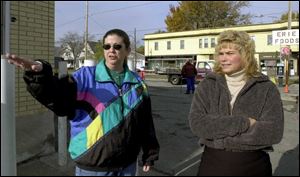
North-end neighborhood looks for economic turnaround
11/11/2002
‘It's going to take years' to revitalize Galena Street, says Rebecca Rumpf, left, pointing out some of the changes in the neighborhood with Kathy Kaufman of the Central City Main Street committee.
Rebecca Rumpf remembers when Galena Street pulsed with activity — everything from beauty shops to a public library.
“We had a post office,” she said. “This was a city. You didn't have to leave the neighborhood.”
Galena, in Toledo's north end, is battered by the passage of time; vacant lots are interspersed with the few remaining businesses.
But all that's changing.
Until 1999, Galena ran only from Summit to Champlain street, and few drove through there who didn't have to.
The opening of the Greenbelt Parkway from downtown to I-280 turned Galena into a busy connector with Summit Street. Traffic quadrupled, 1,200 to 5,500 vehicles a day.
The community is trying to capitalize on the traffic. Galena was chosen a year ago as one of three local commercial districts to be a part of the Central City Main Street program of Toledo, funded by the national Local Initiatives Support Corp.
The local committees get technical aid and training.
One benefit is an architect's ren|dering of how a restored Galena might look. It shows a wrought-iron sign spanning the street, kiosks, brick walkways, new parking, street lights, and public benches.
“It's already happening,” insists Ms. Rumpf. She names two busi|nesses that have ap|plied for city facade grants, and one that is ex|ploring opening a dollar store.
A laundry center is moving in, and the Subway restaurant chain is said to be interested. Discussions in|vol|ving a bakery, an ice cream shop, and a new union hall are said to be in the works.
One initiative the Main Street committee is pushing is to raise money locally for trash bins and new lighting.
A “public tavern” might be welcome, but not a nightclub like the one that burned down a year ago, or the “showgirls” lounge that someone tried to open a few years back. “I think that got us all involved,” Mrs. Rumpf said.
Galena has a smattering of local commerce. A well-stocked grocery store, Erie Foods, anchors the neighborhood at 727 Galena. Homer's Cycle, Inc., is a successful motorcycle parts store at Galena and Ontario Street, kitty-corner from the private North Toledo Arrow Club. Lighthouse Baptist Church is where the library used to be.
There's even a little property speculation going on.
“There's a couple property owners who see this as an opportunity to get rich, and they're setting their price impossibly high, like double or triple,” Ms. Rumpf said. “It's the American way to make a profit, but do you have to make a killing?”
But between those busines|ses are mostly empty lots, and a glance up and down the street suggests traffic hasn't, by itself, produced a business revival.
“There's a lot more traffic — more trucks,” said Dan Gill, a meat cutter at Erie Foods supermarket. “It hasn't really brought customers. It makes access to [I-280] a lot easier.”
Kathy Kaufman, mother of five and a member of the Main Street committee, wants the Galena “downtown” to go back to when people could walk after dark and feel safe.
“I think more people would go down there,” Mrs. Kaufman said. “Right now, it's a place you would not want to go after dark. It's deserted.”
One of the open questions for Galena is the effect that the new I-280 span will have. The approach to the bridge is expected to be visible above rooftops from Galena.
Mrs. Kaufman hopes the old I-280 route becomes a park, enabling a bike/hike trail to East Toledo. The group hopes to open a public access to the Maumee River at Jamie Farr Park across Summit Street.
At one time, Galena Street was near the center of industry in Toledo, as suggested by the many exits off old I-280. It was the northern turnaround of the trolley system, residents say.
There is still a lot of industry, including Henry Gurtzweiler, Inc., steel erectors and the Lib|bey Glass factory. But little wealth is evident in the modest dwellings.
“It used to be really built up. Then, over the years, people started moving out and it be|came very desolate. Some of the business buildings got burned down,” Mrs. Kaufman said.
“The neighborhood residents would like to see places where they can grab lunch, where they can do their laundry,” said Kim Cutcher, interim director of NorthRiver Development Corp.
Ms. Cutcher said the goal of the Main Street program is to show entrepreneurs that a neighborhood has more economic potential than might be immediately obvious.
“Research indicates that there is disposable income in the central city; it's just an untapped resource. Business owners, I think, are unaware. It's just a matter of making a connection,” she said.
Mrs. Rumpf knows many of the people she meets on the street. She talks up the Main Street project to the building owners she meets.
“It's a very slow process. It's going to take years,” she said.